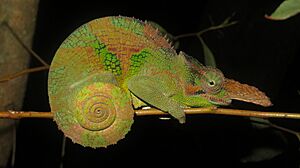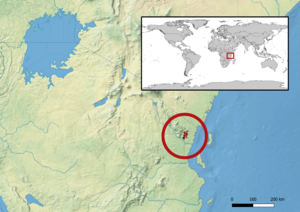Kinyongia vosseleri facts for kids
Quick facts for kids Kinyongia vosseleri |
|
|---|---|
 |
|
 |
|
| Male above, female below | |
| Conservation status | |
| Scientific classification | |
| Genus: |
Kinyongia
|
| Species: |
vosseleri
|
 |
|
| Synonyms | |
|
|
The Kinyongia vosseleri is a special kind of lizard. People often call it the Usambara two-horned chameleon or Vosseler's blade-horned chameleon. It belongs to the family of Chamaeleonidae, which are known for their amazing color changes and unique eyes. Sadly, this chameleon is an endangered species. This means there are not many left in the wild. It lives only in one country, Tanzania, which makes it endemic to that area.
How It Got Its Name
This chameleon was first described as a unique species way back in 1913. A scientist named Fritz Nieden gave it its scientific name. The second part of its name, vosseleri, honors a German zoologist named Julius Vosseler.
For a long time, people thought this chameleon was the same as another species, Kinyongia fischeri. Scientists call this being a "synonym". But in 2008, new research showed that they are actually two different species. They live in completely separate places, which helped scientists confirm they are distinct.
Where Does It Live?
The Kinyongia vosseleri chameleon is found only in the forests of the East Usambara Mountains in Tanzania. These mountains are in eastern Africa. It lives at high altitudes, up to about 1,500 meters (or 4,900 feet) above sea level.
Its home in the East Usambara Mountains is also shared by a close relative, the Kinyongia matschiei. Another related chameleon, the Kinyongia multituberculata, lives in the West Usambara Mountains.
What Does It Look Like?
The Kinyongia vosseleri is a medium-sized chameleon. It can grow up to about 29.5 centimeters (or 11.6 inches) long. More than half of its length is its tail! Female chameleons of this species are usually a bit smaller than the males.
One of the most interesting features of this chameleon is its horns. Adult males have a large pair of horns on their nose. These horns point towards each other. What's really special about Kinyongia vosseleri is that the adult females do not have any horns at all! This is quite unique among the "two-horned Usambara group" of chameleons. For example, females of Kinyongia matschiei and Kinyongia multituberculata have small horns. Young chameleons of all these species usually don't have horns.
The only other close relatives where the adult female lacks horns are Kinyongia boehmei and Kinyongia tavetana. However, these chameleons do not live in the Usambara Mountains.
See also
- Trioceros deremensis, the Usambara three-horned chameleon


